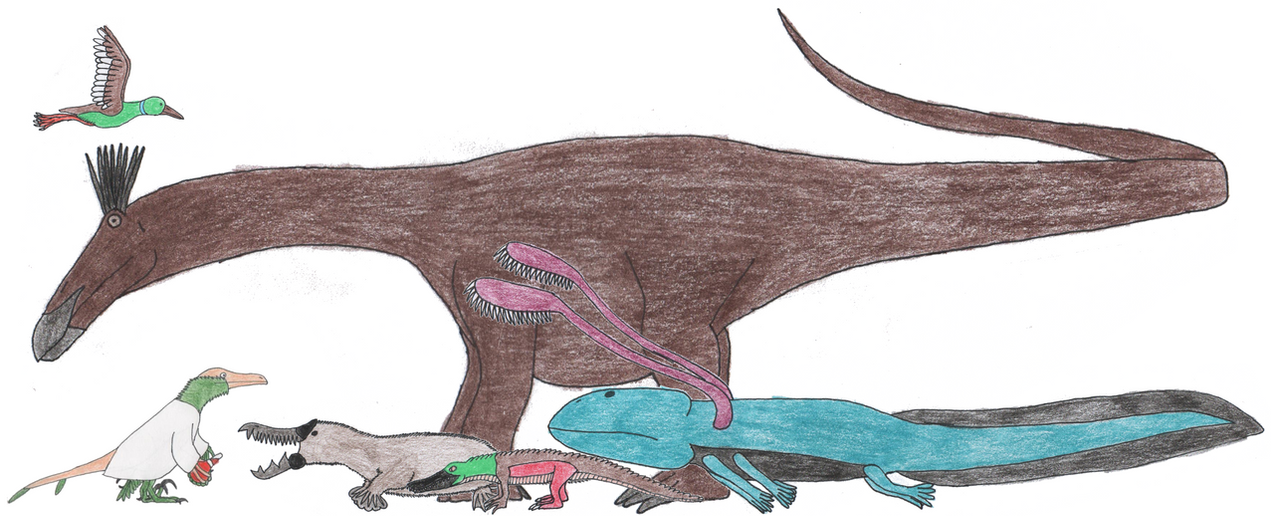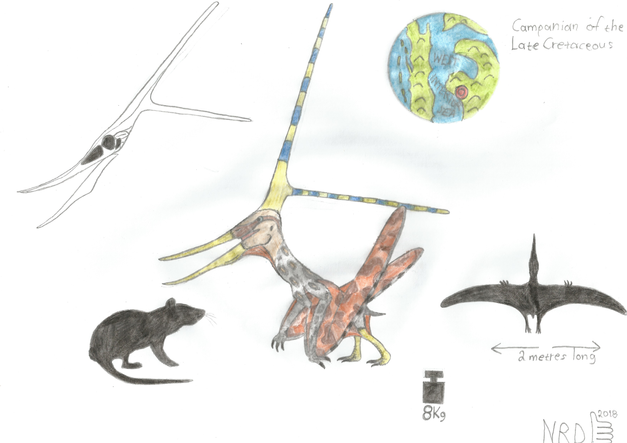HOME | DD
 Oaglor — Extinct Five of Ponodas
Oaglor — Extinct Five of Ponodas

#monotreme #anatosuchus #clashofthetalons #displacerbeast #extinctanimals #platypus #nigersaurus #koolasuchus
Published: 2019-05-07 20:51:58 +0000 UTC; Views: 3434; Favourites: 30; Downloads: 7
Redirect to original
Description
In the wetlands of Ponodas, the waters are heavily polluted due to the alchemical works of the Mossdashers. While some species ( www.deviantart.com/oaglor/art/…) were able to adapt to this Chromaraptor-made change, others perished. Shown here are five such species:Neckstrap Wader (bird on upper left): With all the ponds, lakes, and streams coursing through the land, Ponodas probably has the most diverse avian fauna in the entire continent of Konureth. Among these many bird species is the Neckstrap Wader (Zongopteryx inutilis). Of all the birds found in Ponodas, Neckstrap Waders were generally considered the most useless, yet least troublesome of them all. Their meat was generally considered low-quality, none of their parts could be used for alchemical reagents, yet they generally stayed away from Mossdasher settlements and didn't make much noise. Though they were able to adapt to the pollution of Mossdasher activities, the Neckstrap Waders ended up being killed off thirty years ago by the presence of two invasive predators: the Dark Kaybuds and the Hover-Serpents. With their affinity for trap making and their not-so-picky appetite, the Dark Kaybuds became adept bird catchers, and the Neckstrap Wader became one of their most frequent targets due to being large enough to feed four Kaybuds for a day. Things only got worse fifty years ago when large flying serpents spread throughout Ponodas, feeding on all manner of warm-blooded prey, including the Neckstrap Waders.
Lumberbill Gargantuan (sauropod on middle): The last known species of Gargantuan to be found in northwestern Konureth, the Lumberbill Gargantuan (Ponodasaurus palusiphilus) was an unusual rebbachisaurid sauropod with a narrow body and large head in order to capitalize on the various ferns, shrubs, and small trees found throughout Ponodas. Besides some individual Hulk-Fishers with stronger jaws, adult Lumberbills lacked natural predators and were surprisingly mellow as far as large herbivores go. However, for the past few hundred years, Lumberbill numbers have steadily plummeted due to thinning eggshells as a result of some of the chemicals that seeped into the water. The last known Lumberbill was a bull used as a siege animal by the Blackfen Kaybuds during their raids on Mossdasher settlements. This individual, posthumously named "Big Bubba", was killed during the Siege of Potion Well seventy years ago.
Greater Tambreet (monotreme on lower left): It's a mystery how the wetlands of Ponodas can support as many aquatic ambush predators as it does. From the Coldwater Gator to the Tuskorc, there were a total of 25 different species of metasuchians in recent history, 18 of which were aquatic ambush predators. Even if niche partitioning is taken into account, there still shouldn't be that many different crocs waiting around in the various bodies of water of Ponodas. However, there used to be other ambush predators waiting in the water as well besides the crocs. One of these was the Greater Tambreet (Caedorhynchus ingens), a very large monotreme with a hardened beak lined with serrated edges akin to teeth. Unlike their cold-blooded competitors, Greater Tambreets purposefully waited at areas with high prey traffic in order to fuel their high metabolism. While their numbers suffered due to overhunting for their hides, eggs, and the poisoned spur on the male's hind feet, what did the Greater Tambreets in was the recent Great Drought brought about by Sandrunner forces. While the many different metasuchians were able to go into torpor to sleep through the drought, the Greater Tambreets all starved to death.
Quock (notosuchian on bottom middle): The Quock (Spatulasuchus oleumiferous) was a notosuchian that mainly waded along shorelines, feeding on all manner of small fishes, amphibians, and invertebrates. Unlike many of the crocs found in Ponodas, Quocks migrated throughout the entire region in accordance with the seasons. This allowed nutrients to be distributed throughout Ponodas via their droppings. Unfortunately, despite being largely useless for alchemy, they were killed nonetheless by charlatans in order for their parts to be used for so-called "miracle cures". Despite authorities dismissing these "Quock Oil Ointments", the demand for them meant that Quocks were still being killed off at unsustainable rates. The last Quock was kept as a pet by Shing the Recipe Master until they were killed by a hurricane ten years ago. When an untested recipe for a resurrection potion was found in Shing's hidden archive, a crack team of master alchemists was assembled to try to create such a concoction. Figuring that they may as well test the potion by trying to bring back the Quock, the alchemists dropped samples on several specimens. However, as if by divine intervention, the dead Quocks were transformed into a most unusual form: that of a waterfowl with the head of typical crocodilian. Before they could be captured, the newly dubbed Cwacks managed to fly away before anybody could capture them. Not much can be found about them, but their numbers are steadily multiplying over the past five years.
Confusion Beast (temnospondyl on lower right): Among the top predators of Ponodas's waters were the last known temnospondyls in Konureth: The Confusion Beasts (Dolusuchus pseudolocus). While most of the aquatic ambush predators had to leap out of the water to attack their prey, Confusion Beasts relied on two special adaptations. The first of these is a pair of long, squidlike tentacles hooked with barbs capable of grabbing prey and dragging it to the water. Their second adaptation is the magical ability to appear like it is several feet away from where it actually is. Unfortunately, as with many amphibians, Confusion Beasts breathed through their skin which made them vulnerable to the ever-increasing number of chemicals being dumped into the waters that they lived in. This was made worse by the invention of revealing powder which sticks to the skin of invisible targets where sprayed. With a way to get around the Confusion Beast's main line of defense, Mossdasher hunters ended up killing them off due to the high demand for their parts, particularly their tentacles. The last Confusion Beast was slaughtered 54 years ago after evading Mossdashers for over 30 years.
The design of the Neckstrap Wader is based on the Bone Butte Bird from Saurian.
The Lumberbill is based on Scott Hartman's Nigersaurus.
The Confusion Beast was inspired by the Displacer Beast from Dungeons and Dragons which is owned by Wizards of the Coast.
The coloration of the Confusion Beast is based on the Demon Cat from the Adventure Time episode "Dungeon". Adventure Time is owned by Cartoon Network and Frederator Studios.
The coloration of the Quock is partially based on that of the Northern Shoveler.


























